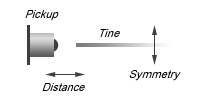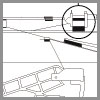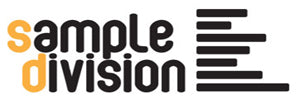
LOUNGE LIZARD EP-4
EP-4 Electric Piano
Lounge Lizard EP-4 is the recreation of classic electric pianos and delivers the authentic tone of the originals, while also preserving their action and feel.
Once again, AAS raises the bar in the recreation of the classic electric pianos. Once you get your hands on Lounge Lizard, that elusive electric piano sound becomes a vivid reality.
Using AAS's award winning physical modeling technology, they've come up with refinements that take one of the most impressive and unanimously acclaimed software to another level.
Custom tone
Famous players all had their own signature sound. This was achieved by tedious manual adjustments of forks, hammers and pickups. Whether you are looking to emulate a particular sound or simply find your own, you have direct access to all piano components.
Hammer
Control the attack with the hammer. Adjust the force of the impact, the stiffness of the hammer and the noise it makes. Modulate these across the whole keyboard range or depending on the MIDI velocity.
Fork
A sweet sound is produced when the hammer hits the fork. Control the tone and its envelope by selecting material and natural decay of the tone and tine bars forming the fork.
Pickup
Like in an electric guitar, a pickup near the fork captures its vibration. Adjust the pickup position and control distortion. Get a warm smooth tone or make your piano growl or bark.
Damper
Control how dampers are raised from or applied on the fork and make the attack and release of a note clean or noisy.
Tremolo
Adjust the tremolo to perfection. Use a triangle shape for a smooth effect or a soft square wave to obtain a chopped effect typical of suitcase pianos.
NEW Features in Lounge Lizard EP-4 to version 4.3.0
- New Library - The completely renewed factory library features classic electric piano sounds as well as over 240 gig- and mix-ready custom electric pianos making good use of the compressor, equalizer, and multi-effect processor.
- New Compressor and equalizer - These new additions are designed to add punch and definition to your sound, letting you cut through any dense mix or stage.
- New Character control - The new Character control provides five classic studio and stage signal path emulations—that's the cabinet, pre-amp, microphone, and recorder chain that follows the piano's output—to help fit your electric piano part into your track.
- New Streamlined interface - Redesigned from the ground up, the new interface now divides Lounge Lizard EP-4 into three panels: Play presents shortcuts to the main piano and effect parameters including bypass switches for quick edits; Edit lets you get under the hood and voice the piano to taste; while FX supplies equalizer, compressor, multi-effect, and reverb processors for final shaping duties.
- New Limiter - The new output limiter protects your ears and monitors during experimentation with the piano's physical modeling parameters while providing a maximum of distortion-free dynamics.
- New Bank and program manager - Lounge Lizard EP-4's new manager allows simple and efficient organization, backup, and sharing of your sounds.
- Overhauled effects - Reinvigorated, polished, and tuned especially for the electric piano, Lounge Lizard EP-4's multi-effect processor features our best sounding chorus, delay, phaser, flanger, distortion, notch filter, wah-wah, auto-wah, and reverb to date.
- New Microtonal tunings via Scala scale files - Lounge Lizard EP-4 now supports the Scala scale file format for microtonal music making.
- Resizable user interface
The update is free for all registered Lounge Lizard EP-4 users on the AAS website.
Other Key Features of Lounge Lizard EP-4:
- The brand new modeling library fully exploits the refinements and covers all your electric piano needs
- The high-end effects section has been extended with tremolo, wah, chorus, phaser, delay, reverb, and EQ making Lounge Lizard a complete and self-contained electric piano solution
- Two pickup types are now available for a wider character range: electromagnetic and electrostatic. In addition, scaling has been added for even volume across the entire keyboard
- The new and improved Fork model adds upper harmonic content for an even more authentic sound
- The improved Damper now closely interacts with the Fork and provides superb dynamic response
- The integrated Audio Recorder captures inspired moments on the fly
- Custom tunings are now possible with the added support for Scala files
- All the classic electric piano sounds
- Entirely based on physical modeling for outstanding sound quality
- Top quality preset library—vintage to modern
- Integrated browser and locate function for easy navigation and organization of presets
- Fast preset loading time
- Hands-free operation via custom MIDI programs
- Every parameter can be controlled via MIDI or host automation
- Intuitive and ergonomic user interface for preset creation
- Fast installation
- Real-time calculation of sound. No samples
- 32bit floating point internal processing
- Sample rates up to 192 kHz
- Import/Export functions for easy sharing of presets
- Unlimited undo/redo capability
- Standalone operation. No host application required, and standard plug-in format support
- Full audio and MIDI hardware support
- Simultaneous operation of multiple MIDI ports
- User defined MIDI maps with MIDI Learn function
- MIDI clock, tap and host tempo synchronization
- Dynamic voice allocation and CPU overhead protection
Presets and Effects
Lounge Lizard comes with an extensive preset library that is simply inspiring, giving you access to the classic electric piano sounds popularized by musical legends like Chick Corea, Herbie Hancock, Stevie Wonder, and George Duke. There is a choice of pure and true tones as well as a selection of processed ones courtesy of the high-end effects section.
The effects section includes the classic tremolo, chorus, wah, and phaser effects as well as EQ, delay and reverb. These effects are specially designed for the electric piano, making it very easy to create your own distinctive custom tones.
EP Character and Beyond
The original electric pianos provided timbre and volume adjustments by letting you position the tines in relation to the pickups. These adjustments were at the heart of the electric piano's character as they controlled the harmonic content, attack, and decay of the sound, offering unique tone to each player. But there was a price for this flexibility. Several painstaking hours with a screwdriver and incredible patience was needed to change the sound of an electric piano.
Suffer no more! With Lounge Lizard, the preset library provides a selection of thoroughly chosen Tine/Pickup configurations. You also have the ability to make those adjustments in real time via two simple controls: Distance and Symmetry.

It doesn't end there. Because controls are provided for the various electromechanical components, Lounge Lizard can be pushed far beyond hardware equivalents, opening up a completely new realm of sonic possibilities!
What's more, since the interaction between the tine and pickup is quite unique, its effect can't be obtained with the filtering provided by samplers. This limits sampled solutions to one or two fixed configurations and brings physical modeling to the forefront of the electric piano recreation.
Modeling an Electric Piano: How it works
The electric piano was invented by Harold Rhodes (1910-2000) during the forties when he was in the army. The first instruments he built were made of aircraft pieces and were intended to entertain army servicemen. It became a very popular instrument in jazz and rock, and has enjoyed a resurgence in recent years through it's extensive use by the world's top hip hop, R&B, and house producers.
The mechanism of the electric piano is, in fact, quite simple. A note played on the keyboard activates a hammer that hits a fork. The sound of that fork is then amplified by a magnetic coil pickup and sent to the output, very much like an electric guitar.

Mac minimum system requirements*
- Mac OS X 10.7 or later
- Intel Core processor or later
- 512 MB of RAM
- 70 MB of free hard drive space
PC minimum system requirements*
- Windows 7 32/64-bit or later
- Intel Core or equivalent processor
- 512 MB of RAM
- 70 MB of free hard drive space
*The minimum system requirements mentioned above are for standalone usage. For plug-in usage, please refer to your DAW software requirements (Sonar, Pro Tools, Cubase, Live, Digital Performer, Logic Pro, etc.)
